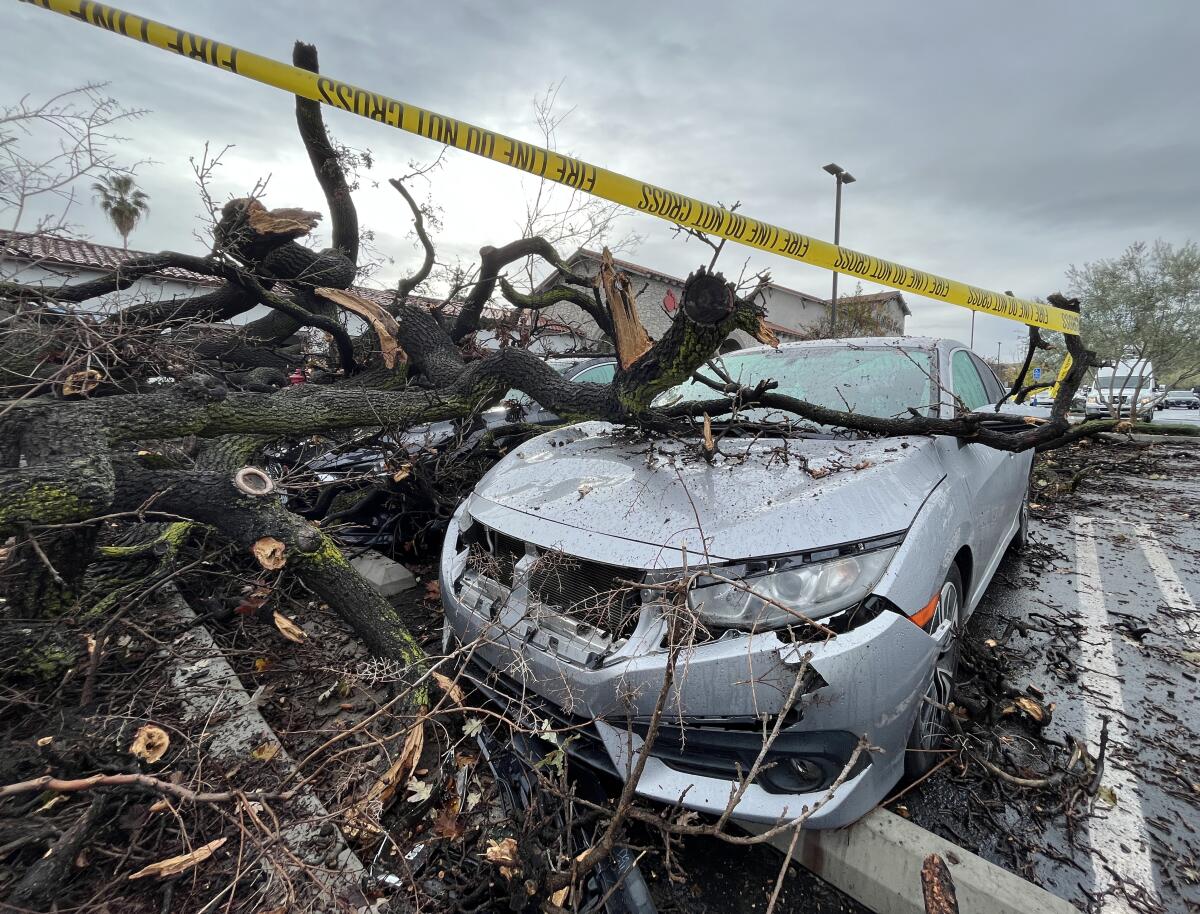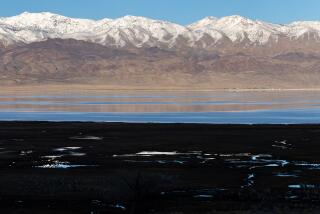California bracing for one final round of storms as officials assess damage

SACRAMENTO — Another moderate storm moved into California Sunday evening, bringing more rain to Los Angeles, the coast and inland valleys, and dropping potentially up to 2 feet of snow in the mountain regions of Northern California before it moves east on Monday.
The National Weather Service in Los Angeles issued a winter storm warning for elevations above 5,000 feet, including Lake Arrowhead, Big Bear, Running Springs and Wrightwood. The service cautioned motorists traveling to and from the San Bernardino Mountains to expect gusty winds and limited visibility, and warned of potential snow at the Grapevine I-15 corridor Monday and Tuesday.
But meteorologists also say there’s good news on the horizon. The series of storms that has ravaged the state, flooding communities, forcing evacuations, shutting down major highways and leading to at least 19 deaths, should come to an end this week.
“It looks like a dry period that we haven’t seen since the day after Christmas when this all started,” said Eric Kurth, a meteorologist with the National Weather Service in Sacramento.
The dry spell is expected to begin in Southern California on Tuesday, while those living along the North and Central Coasts, and in the San Francisco Bay Area and Sacramento region, will probably have to wait until Thursday. A light rain system is forecast to hit these already saturated areas on Wednesday.
Once the rains have dissipated, state and local officials will begin to assess longer-term rebuilding efforts in areas heavily damaged by the storms.
The Biden administration on Saturday approved Gov. Gavin Newsom’s request for a presidential disaster declaration to support the state’s response to flooding, mudslides and landslides in California, where 41 counties are under emergency declarations.
Brian Ferguson, a spokesperson for the Governor’s Office of Emergency Services, said the state continues to monitor the Monterey Peninsula and the Salinas River, where a flood warning remains in effect near the town of Spreckels.
Concerns that river flooding could cut off communities, such as Monterey and Carmel, on the peninsula have abated, though the state is still closely watching water levels on the river.
Debris flows along Highway 1 slowed and stopped traffic in Monterey County, while the National Weather Service forecast snow for the upper peaks of the Santa Lucia Mountains — which run along the Central Coast from Carmel to the Cuyama River in San Luis Obispo County.
Farther south, mudslides are a top concern in Santa Barbara.
“Santa Barbara, that’s a different challenge and maybe a more challenging situation, because there the threats are all about land movement,” Ferguson said, adding that mudslides present a major risk even after the storms pass.
He said the California National Guard is working to get debris out of flood control channels and improve drainage to lessen the impact of mudslides. Overall, the state has recorded 402 landslides since Dec. 30.
In Merced County, levee breaks on Bear Creek led to several feet of water in homes and schools, creating a need for another long-term recovery effort, he said.
Santa Cruz experienced “high tides, storm surges, wind and water all at the same time,” causing significant damage to the state beach and the town of Capitola, Ferguson said.
“The water movement out of the Santa Cruz Mountains just moves so quickly that there is pretty significant damage to roads and bridges and other work that may take longer to recover from as well,” he said.
In Southern California, an Orange County swift water rescue team on Saturday airlifted a woman to safety from rushing waters along a creekbed. Using a harness, the helicopter crew rescued the woman, who was clinging to a tree, and hoisted her to a clear landing where firefighters and paramedics were waiting.
Later that evening a giant tree crushed at least 10 vehicles and caused minor damage to a building at the El Camino Shopping Center in Woodland Hills.
On Sunday night, rescue teams pulled a man from a storm channel in Cypress.
Weather conditions led officials in San Luis Obispo on Sunday morning to once again suspend the search for 5-year-old Kyle Doan. His mother lost control of their vehicle when she was driving him to school Monday morning and the boy was swept away by floodwaters near San Miguel Creek. The search for Kyle has been repeatedly halted due to dangerous conditions.
Another flood warning remains in effect along the Sacramento River, affecting Glenn, Butte and Tehama counties.
Coastal flood advisories remain in effect for beaches in San Luis Obispo, Santa Barbara, Ventura, Los Angeles, Monterey and San Francisco counties. The National Weather Service warned of high tide flooding in low-lying parking lots, beaches and walkways and increased risk of drowning due to rip currents.
Ferguson said that while Californians have learned to avoid danger during more common disasters, such as wildfires, officials are still trying to educate people about flood risks.
“The most challenging thing actually remains human behavior,” Ferguson said. “There’s just been a lot of people who put themselves in harm’s way by either driving on roads where they shouldn’t have been or not heeding closures, and so that’s the place where I see work to be done to help Californians understand that floods are as deadly and as challenging as wildfires or as earthquakes.”
The powerful atmospheric river storms that have dumped trillions of gallons of precipitation onto the state have offset another lingering California problem: drought.
The National Weather Service in Sacramento has recorded 11.33 inches of rain since Dec. 26 through Saturday, which is more than half of the rainfall the region typically gets in an entire year. Monterey reported 7.56 inches in that same period.
As of Thursday, 0% of the state was in exceptional drought, and only a tiny portion of far Northern California, 0.32%, was in extreme drought, according to U.S. Drought Monitor.
It’s the first time that’s happened since April 4, 2020, when none of the state was classified in those categories, according to Richard Tinker, a meteorologist with the National Oceanic and Atmospheric Administration and one of the authors of the drought monitor.
Staff writers Hayley Smith and Susanne Rust contributed to this report.
More to Read
Sign up for Essential California
The most important California stories and recommendations in your inbox every morning.
You may occasionally receive promotional content from the Los Angeles Times.











